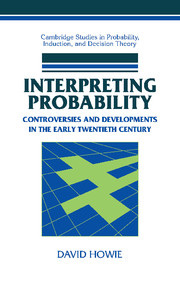Book contents
- Frontmatter
- Contents
- Acknowledgments
- 1 Introduction
- 2 Probability up to the Twentieth Century
- 3 R.A. Fisher and Statistical Probability
- 4 Harold Jeffreys and Inverse Probability
- 5 The Fisher–Jeffreys Exchange, 1932–1934
- 6 Probability During the 1930s
- 7 Epilogue and Conclusions
- Appendix 1 Sources for Chapter 2
- Appendix 2 Bayesian Conditioning as a Model of Scientific Inference
- Appendix 3 Abbreviations Used in the Footnotes
- Bibliography
- Index
5 - The Fisher–Jeffreys Exchange, 1932–1934
Published online by Cambridge University Press: 07 July 2009
- Frontmatter
- Contents
- Acknowledgments
- 1 Introduction
- 2 Probability up to the Twentieth Century
- 3 R.A. Fisher and Statistical Probability
- 4 Harold Jeffreys and Inverse Probability
- 5 The Fisher–Jeffreys Exchange, 1932–1934
- 6 Probability During the 1930s
- 7 Epilogue and Conclusions
- Appendix 1 Sources for Chapter 2
- Appendix 2 Bayesian Conditioning as a Model of Scientific Inference
- Appendix 3 Abbreviations Used in the Footnotes
- Bibliography
- Index
Summary
ERRORS OF OBSERVATION AND SEISMOLOGY
In the preceding two chapters I have described how the statistical methods of Harold Jeffreys and R.A. Fisher evolved from their respective disciplinary experiences in geophysics and genetics. During the twenties their methods exerted little mutual influence. The statisticians who comprised Fisher's audience were too aware of the shortcomings of inverse probability for him to provide anything more than general criticisms as he cleared the way for his likelihood and fiducial techniques; Jeffreys intended his theory primarily as an account of inference to rival that of the philosophers, and his objections to the frequency interpretation had little impact in statistical circles. Following the publication of Scientific Inference, however, Jeffreys started to apply inverse arguments directly to data analysis. Between 1932 and 1934, he and Fisher clashed over one of these applications. The exchange forced each to re-examine his methods.
The genesis of the debate can be traced to Jeffreys's involvement with seismology. Following his work with Wrinch on the Oppau explosion, Jeffreys had increasingly come to see earthquakes as an ideal way to probe the Earth's interior. The empirical situation, however, was somewhat akin to that Fisher had found on arrival at Rothamsted. Though abundant, the data was in too raw and unrefined a form to be of much use in geophysical inference. Turner's International Seismological Survey had published extensive quarterly records since 1918, but the rudimentary calculations of average earthquake travel times were thought to be out by up to 30 seconds.
- Type
- Chapter
- Information
- Interpreting ProbabilityControversies and Developments in the Early Twentieth Century, pp. 128 - 170Publisher: Cambridge University PressPrint publication year: 2002
- 1
- Cited by

